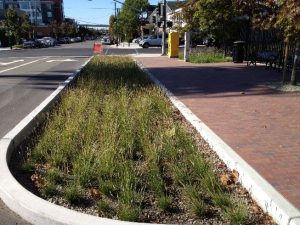
Photo: Retrofit bioretention cell in Emeryville, CA
Scott Taylor, P.E., D.WRE is the Vice Chair of the National Municipal Stormwater Alliance, a 501c3 formed to champion MS4 issues and programs at the national level. Scott reviews the new EPA Guide titled, “Community Solutions for Stormwater Management – A Guide to Long Term Planning.”
We have just finished up the back-to-school season. Department store displays full of school clothes and other must-haves, mall store special sales, kids at Supercuts, some excited, some with grim faces. Best I could gauge, there was a palpable mixture of excitement and dread. The student mission: Acquire knowledge. Kepler, Yates, Shelly, Einstein, Newton, the first law thermodynamics (I took the STEM path). The science world is filled rational, proven concepts and general agreement on the facts. But this does not seem to be the case for stormwater. There are many ways to attack the problems. However, until we can clearly articulate our vision we are in a difficult position, and in an even more difficult sales position with the public.
To move toward solving this problem, the USEPA has developed a new guide to help communities establish a plan, a vision, for how stormwater can serve as an important component of the urban landscape. The Guide is unique in its approach as noted in the introduction, “…managing stormwater over the long term can create opportunities for communities to rediscover rainwater as a resource, invest in resilient infrastructure, revitalize urban waterways and introduce green space that makes communities more livable.” Indeed, for decades stormwater, and all of water, has been a ‘me too’ industry, content with avoiding innovation and operating in established silos (think about how stormwater, domestic water and wastewater systems are planned and operated).
The Guide helps stormwater planners develop a long-term stormwater plan that is integrated with other community planning elements. The overall steps described in the guide include:
- Assessment (community objectives, current water quality in the community)
- Analyzing opportunities (getting partners, educating the public, needed infrastructure investments and approaches to improve infrastructure)
- Implementation (the most difficult part – develop a schedule and a budget! Track performance and feed information back into the plan)
- Documenting the benefits (the cost savings, benefits that are difficult to monetize)
EPA is pilot-testing the Guide in five communities across the US and has also developed an on-line toolkit to assist in developing the long-term plan and implementing the steps in the Guide. The Guide and online toolkit can be accessed here: https://www.epa.gov/npdes/stormwater-planning.
This publication is worth your time if you are currently, or in the near term developing a stormwater plan for your community. Too often the ‘plan’ is to implement the requirements of the MS4 permit. This approach spurns innovation and greatly limits your potential to leverage stormwater assets. Cities of the future will be built around water. We need to change how the public values water. It all starts with a good plan.
If you don’t know where you are going, any road will get you there – Lewis Carroll




